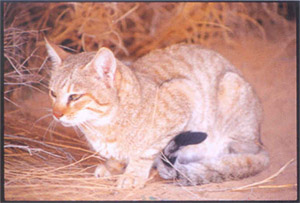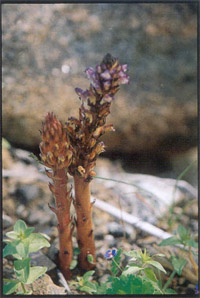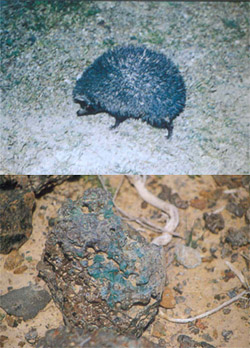|
One
of the most beautiful areas of the UAE
lies to the south of the curve that is
made by the Dhaid-Masafi highway near Siji.
Wadi Ashwani is one of the tributaries of
wadi Siji, and it has its origin high up
in the mountains that overlook the
Masafi-Fujeirah road.
 I was introduced to this wadi many years
ago and have enjoyed countless walks and
camping trips there. In years of good
rainfall the downstream part of the wadi
is a favourite picnic spot for local and
expat families, because this part of the
river can be reached by car. There are
former farming fields bordering the river,
with many Acacia trees providing shade, so
camping is easy and if the river is
running, water is nearby.
I was introduced to this wadi many years
ago and have enjoyed countless walks and
camping trips there. In years of good
rainfall the downstream part of the wadi
is a favourite picnic spot for local and
expat families, because this part of the
river can be reached by car. There are
former farming fields bordering the river,
with many Acacia trees providing shade, so
camping is easy and if the river is
running, water is nearby.
Further upstream the track splits up into
two branches with the main track following
a left curve and crossing the river to
lead eventually to the village of Diftah
on the Masafi-Fujeirah road. The track
that continues straight becomes very rough
and fewer people venture this far. After
rains some of the wadi crossings are
impassable and you have to continue on
foot. The track stops at a small fenced
plantation right beside the stream. Some
people have managed to continue further
with their cars, but after rains it is
better to cross the wadi on foot. The
track winds uphill and almost immediately
you can see some odd-looking rocks. They
are very dark and have a molten appearance
with bits of green inclusions here and
there. These are the remains of an active
copper mining enterprise that took place
here many hundreds of years ago. Copper
ore was dug up in mine pits that usually
resembled deep wells. It was then put into
clay pots that were filled to the brim
with wood. The many Acacia trees of the
area must have come in handy! When the
wood was lit, the heat of the fire melted
the copper ore, and the copper ran down to
the bottom of the pot, which was shaped
like a shallow dish. When the job was done
and the pot had cooled down, it was broken
and the disc of copper that had solidified
at the bottom was removed. One of the
walls surrounding the fallow fields of the
farm is built almost completely from large
rocks of old copper slag.
 Further upstream the walk leads over rocky
outcrops and low hillsides, which in years
of good rainfall are covered with dozens
of species of wildflowers. I have found
many interesting and beautiful plants
there in the last fifteen years. I never
thought I would find flax in the desert,
but this is where I first noticed the
pretty yellow flowers of Linum
corymbulosum. The rather rare Grewia
tenax bush grows here, as does the
hairy plant with the yellow-spotted leaves
that is called Anchusa
aegyptia. At one bend the wadi bed has
deepened into good-sized pool. It is a
perfect place for a coffee stop, as some
large sidr
trees provide shade. In the grass below
the tree grow strange-looking parasitic
plants called broomrape (Orobanche
cernua). They come in two colours -
purple and dirty-white. They usually grow
on the roots of a member of the nightshade
family (Solanum) which is represented here
by the Desert thorn Lycium
shawii.
Further upstream the walk leads over rocky
outcrops and low hillsides, which in years
of good rainfall are covered with dozens
of species of wildflowers. I have found
many interesting and beautiful plants
there in the last fifteen years. I never
thought I would find flax in the desert,
but this is where I first noticed the
pretty yellow flowers of Linum
corymbulosum. The rather rare Grewia
tenax bush grows here, as does the
hairy plant with the yellow-spotted leaves
that is called Anchusa
aegyptia. At one bend the wadi bed has
deepened into good-sized pool. It is a
perfect place for a coffee stop, as some
large sidr
trees provide shade. In the grass below
the tree grow strange-looking parasitic
plants called broomrape (Orobanche
cernua). They come in two colours -
purple and dirty-white. They usually grow
on the roots of a member of the nightshade
family (Solanum) which is represented here
by the Desert thorn Lycium
shawii.
The wadi is not only one of the best
botanical sites in the country. There is
also plenty of wildlife. The most obvious
and the largest of the animals that use
the wadi system are the feral donkeys that
watch you from the hilltops. Once popular
as a means of transport in the days before
roads and cars, they have long since been
turned loose, forced to fend for
themselves, and managing to do so in spite
of the harsh conditions.
Smaller wildlife is represented by snakes
of which we have seen both the rear-fanged
type and the viper between the rocks along
the wadi banks. Since none of the local
snakes are aggressive, there is no real
danger exploring the fields and hills, as
long as you watch where you put your hands
and feet.
A friendly night visitor to one of our
camps was the all black hedgehog named
after a Mr. Brandt. (Brandt's hedgehog).
Naturally inquisitive it sniffed around my
tent until it woke up the dog, who was
quite excited by our guest. The hedgehog
immediately rolled up into a ball, as all
hedgehogs do. But as the dog came closer
to sniff at him, he did something that is
peculiar to this particular species only:
it jerked its whole body upward several
times in quick succession, managing to hit
the dog in the nose and frightening it
off. As soon as the dog withdrew, rubbing
its hurting nose, the hedgehog raised
itself high on its funny flat feet and
raced off at an amazing speed. Although
the "private Life" of these
hedgehogs has not yet been studied by
scientists, we do believe that they can
cover great distances each night in their
search for their mainly insect food.
The most wonderful wildlife encounter I
experienced, however, was with the
Gordon's wildcat. This is a true wild cat,
not a feral domestic cat. Felis sylvestris is the origin of our domestic tabby cats and in the
UAE this species is represented by a
subspecies named after a British army
colonel, Col. Gordon.
We had just reached our favourite camping
spots on one of the fallow fields behind
the oasis, when one of our group said:
"Look at that cat!". I was
surprised that a domestic cat would be so
far out in the mountains, away from easy
access to food and water. When I looked to
where my friend pointed, I was even more
surprised to see a Gordon's wildcat
sitting only some 50 meters away. Its fur
blended so perfectly with the colour of
the rocks that it wold have been nearly
invisible if it had not been twitching the
black tip of its tail as its watched the
antics of the dogs. Obviously it was
invisible to the dogs, for they paid no
attention whatsoever. I was so amazed that
I even forgot to photograph it - which is
a shame, for there are very few
photographs of this cat in the wild, and
certainly none as close up as this one
was.
I first came across this Felis
sylvestris gordoni when a friend
managed to breed them in captivity for the
first time. Later I took over this captive
breeding program, and I quickly fell in
love with this charming and brave cat. I
have spoken with people in the mountains
who claim they would rather tackle a
leopard than a wildcat. For wild is what
these cats are. They are impossible to
tame unless they are bottle-fed from the
time their eyes open. And even then, they
are only tame to the person who brought
them up.
 Gordon's wildcat is one of the four
species of wild cat that live in the UAE.
The most famous one now is the Arabian
leopard. That was not always the case.
Prior to 1993 very few people had ever
heard of the leopard or of the other cats:
the caracal and the sandcat.
Gordon's wildcat is one of the four
species of wild cat that live in the UAE.
The most famous one now is the Arabian
leopard. That was not always the case.
Prior to 1993 very few people had ever
heard of the leopard or of the other cats:
the caracal and the sandcat.
The sandcat lives in the sand dunes, now
almost confined to the large sand dune
areas of Abu Dhabi emirate. The caracal is
still reasonably well represented and
roams in all the hills of the Hajar
Mountains and the Ru'us al Jibal, while
only very few leopards are left in both
these mountain ranges. The wildcat is at
home both in the mountains and in the
sands. It even comes close to human
habitations, living opportunistically on
scrap food and domestic livestock such as
chickens. The hot daylight hours it spends
in underground dens, while in the
mountains it probably uses caves also. In
a recent research program aimed at the
wild cat was carried out by employees of
the Sharjah Desert Park it was found that
it uses up to 40 dens within its 25- 40
square kilometer range. These dens are
also used at times by foxes, and fights
over dens between the two animals occur
regularly. Part of the research in Sharjah,
which has not been published yet,
indicated that the cats do come close to
where people live but are easily disturbed
out of their habitat by for instance the
construction of new roads. Living close to
humans poses a two-fold danger to the
wildcat's survival: one is that farmers do
not take kindly to their chickens being
stolen and will kill any cat they can find
- a fate that befell the cat in the study
of the Sharjah Desert Park. It was tracked
to its den by her footprints, after which
the entrance was stuffed with bushes that
were set afire -
a really sad ending to the life of
a beautiful creature.
The other threat is that where people are,
there are domestic cats. And domestic cats
cross-breed with wildcats. The offspring
is no longer pure wildcat and has lost
some of the typical characteristics of
that cat: its mottled markings, the
black-ringed tail, the black feet and the
cream-coloured light parts (never white)
on belly and face. Many wildcat hybrids
live either as feral or domestic cats in
Dubai and surroundings. One male Gordon's
wildcat that escaped from the breeding
cages is still roaming around Al Bada'a
after eight years, populating the
neighbourhood with look alikes.
The captive breeding program ensures
that the pure Gordon's wildcat will remain
part of the natural heritage of the UAE.
They can be seen at both Dubai zoo and the
Sharjah Desert Park as well as in
countless zoos across the world to which
cats from our Dubai breeding program were
sent over the years.
|
